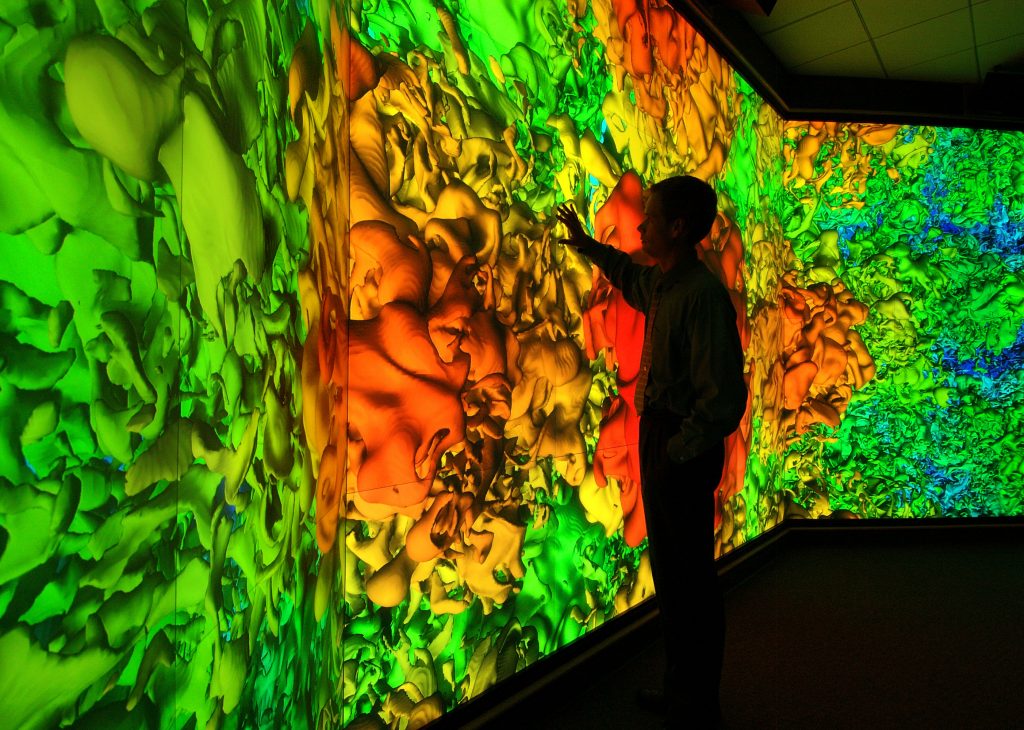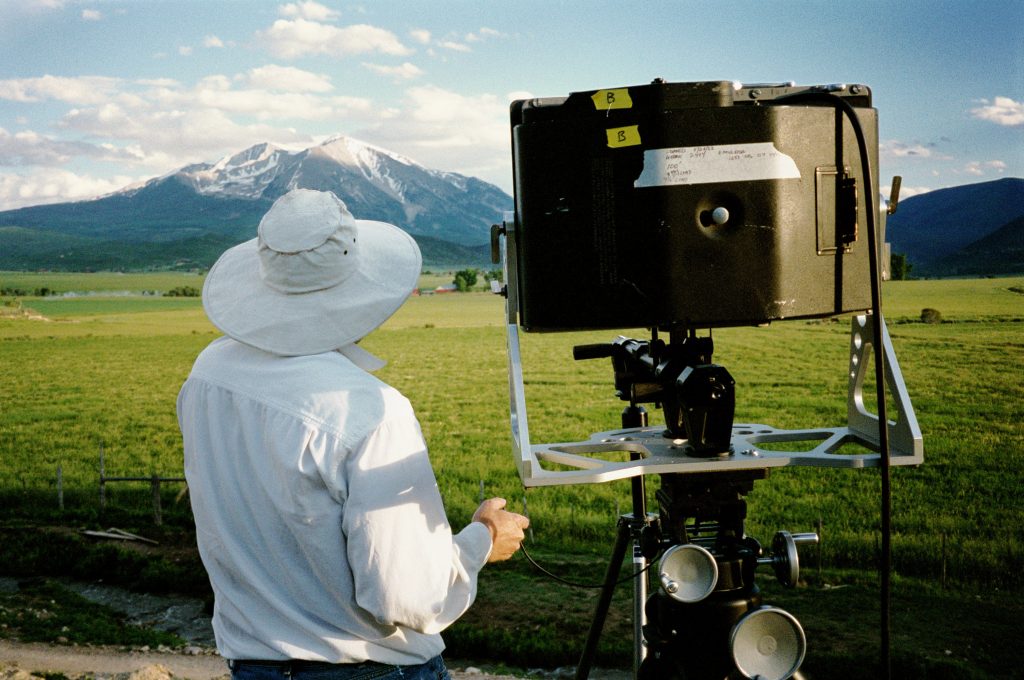
Download 300dpi JPEG image, ‘vis-lab.jpg’, 1.2MB (Media are welcome to download/publish this image with related news stories.)
ALBUQUERQUE, N.M. — An eclectic group of artists and scientists that organizers have dubbed the “dream team” of imaging and visualization are gathered at New York University this week to begin to create a photographic system capable of capturing and displaying a gigapixel — one billion pixels — of visual information in a single image.
The first Big Picture Summit, Dec. 8 and 9, is organized by artist-photographer Clifford Ross and co-hosted by Sandia National Laboratories and the Interactive Telecommunications Program at NYU’s Tisch School of the Arts.
Ross says his goal in bringing together top imaging experts from leading scientific institutions is to bring closer to reality his desire to create a “you are there” photographic experience for those who have not personally witnessed the sublime beauty of natural scenes such as Mt. Sopris in Colorado.
“In the early 15th century, the impulse to render flesh more realistically drove the artist Jan van Eyck to invent oil paint,” says Ross. “The same sort of impulse is driving me, except that I’m trying to capture a mountain. Pixels are simply 21st century oil paint.”

Download 300dpi JPEG image, ‘R1_WorkingMethod6.jpg’, 296K (Media are welcome to download/publish this image with related news stories.)
The scientists have different but complementary goals. Computational scientists at Sandia, a National Nuclear Security Administration lab, believe a display system of the magnitude proposed by Ross will enhance the ability of its scientists to visualize and gain insight from massively complex data sets that can be understood only through human intuition, ranging from supercomputer-generated physics simulations to high-resolution satellite imagery.
“We have a lot in common with an artist like Clifford Ross and his quest to make extremely detailed images that evoke a powerful emotional response,” says Carl Diegert, Sandia computational scientist. “We want to understand from an intuitive standpoint what it is that enables viewers to gain insight — for example, a visual metaphor that makes a human viewer comfortable and thus better able to interact with an image. Computer science alone is not likely to invent a means for scientists to intuitively comprehend highly complex problems.”
“My own goal is to fill the eye with so much information that it overflows and reaches the human heart,” adds Ross. “Art is emotional, but the path is technical, and virtually all the scientists involved in this effort know more about the technical aspects of imaging than I do.”
Ross’ newly patented R1 camera system (www.cliffordross.com/), which broke through the gigapixel barrier, has achieved some of the highest resolution single-shot images ever created. (Efforts by other photographers have digitally melded many smaller images taken over a period of time into single sweeping, gigapixel-sized landscape images.)
The quality of the first landscape images created with the R1 — the “Mountain” series — convinced many of the scientists involved in the Summit to join in the effort, says Diegert.
The 15 professionals invited by Ross to participate in the Summit include renowned artists, scientists and engineers from government agencies, and digital imagery experts from the entertainment and film industries. (See list of participants below.)
The project could have major implications for all industries that rely on precise imaging, including environmental science, space exploration, telecommunications, and homeland security, says Diegert.
The project has two parts. The first is to design and build a new camera, expanding on concepts embodied in the R1, that can capture a gigapixel of digital information at a speed of 1/15th of a second or faster.
The second part is to create the display system, which Ross likens to building an “electronic Sistine ceiling.” It will have 16 times greater data display capabilities than one currently in use at Sandia, among the world’s most advanced. The display would provide an overall view of images at a very large scale while allowing viewers to perceive extremely fine detail.
The Summit is expected to result in a concrete agenda and working group, which would then be funded by interested individuals, foundations, corporations, and government agencies with an interest in the practical implications of Ross’ quest.
“This extraordinary convergence of talent is a promising start,” said renowned digital innovator Red Burns, creator and chair of the Interactive Telecommunications Program at the Tisch School of the Arts. “The group is skilled in virtually all the necessary elements of hardware and software design for a high resolution imaging project of great ambition. Individually, the participants are some of the keenest minds in the field. Collectively, with an unyielding artist in our midst and the right support, there is a chance to create a real breakthrough.”
Read December 9, 2004, New York Times article about the Big Picture Summit
- Richard Benson — Dean, Yale University School of Art / MacArthur Fellow / Photography Pioneer / New Haven, CT
- Red Burns — Creator & Chair, Interactive Telecommunications Program, Tisch School of the Arts, New York University /New York, NY
- Carl Diegert — Lead Computational and Imaging Scientist, Digital Paleontologist, Sandia National Laboratories / former Assistant Professor, School of Engineering, Cornell University / Albuquerque, NM
- Bran Ferren — Co-chairman & Chief Creative Officer, Applied Minds, Inc. / former President, Walt Disney Imagineering / Los Angeles, CA
- Chuck Harrison — President, Far Field Associates, Inc. / Color Scientist / Imaging and Data Security Engineer / Consultant for the Digital Cinema System Standardization Project / Seattle, WA
- Michael Hawley — Director of Special Projects, Massachusetts Institute of Technology / formerly of Bell Laboratories and Lucasfilm / Cambridge, MA
- Clint Hope — Executive Director for Experiential Systems, Applied Minds, Inc. / former Senior Scientist, Walt Disney Imagineering / Los Angeles, CA
- Zoltan Levay — Imaging Resource Lead, Hubble Space Telescope Science Institute, Johns Hopkins University / Baltimore, MD
- Tom McKnight — President, Sensorstar, Inc. / Lead Scientist for Space-Based Telecommunications and Control Systems for Deep Space and Earth Orbiting Spacecraft / Ellicott City, MD
- Michael Naimark — Adjunct Professor, Interactive Telecommunications Program, Tisch School of the Arts, New York University / Adjunct Professor, University of Southern California / Media Artist and Researcher / Los Angeles, CA
- Daniel O’Sullivan — Associate Professor, Interactive Telecommunications Program, Tisch School of the Arts, New York University / Developer, Quicktime VR for Apple Computer / New York, NY
- David Rogers — Imaging and Visualization Scientist, Sandia National Laboratories / former Lead Production Software Engineer, DreamWorks Feature Animation / Albuquerque, NM
- Eric Rosenthal — President, Creative Technology, Llc. / Imaging Consultant for National Security Agency and NASA / former Vice President of Advanced Technology Research at Walt Disney Imagineering/ Morganville, NJ
- Clifford Ross — Artist-Photographer / Organizer, “The Big Picture Summit” / Inventor of the R1 High-Resolution Camera System / New York, NY
- Liron Unreich — Digital Imaging Director, Ross Studio / Photoshop Specialist / former Israeli Army Intelligence Photographic Interpreter / New York, NY